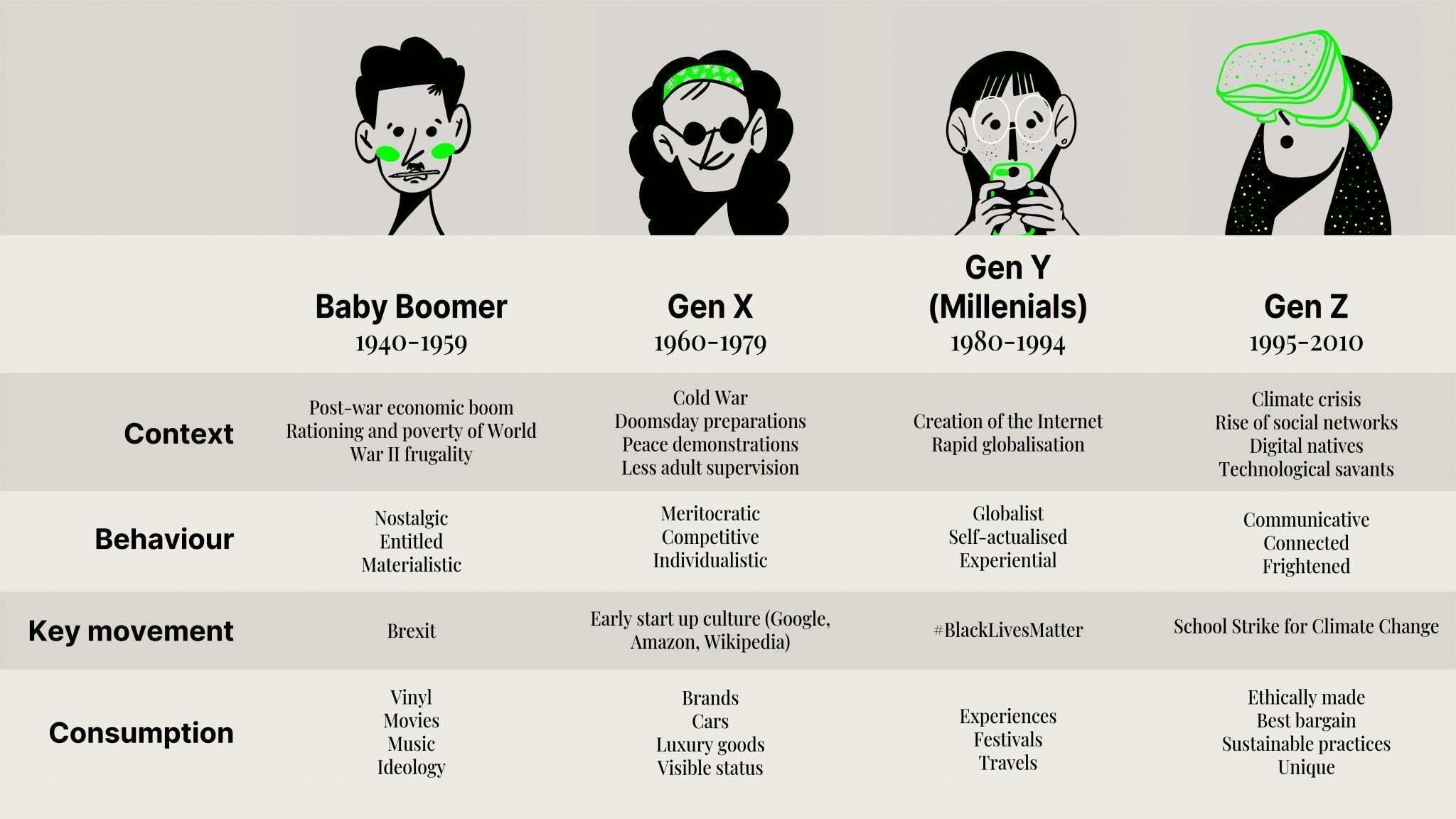On Generations
Generations are a complicated issue. While it is very easy to assign generations to specific dates of birth, there are massive differences between each and every one of us, so when you plonk several billion people into one category you’re bound to be painting with a very large brush stroke.
Marketing to different generations is even more complicated because it keeps changing. Even if you subscribe to the fact that a generation is somewhat homogeneous, you still need to keep the context of the generation evolving as it becomes affected by the things that happen to it. Take Millenials. While we were all trying to understand Millennials, they went and grew up and are having kids. They’re settling down and becoming the generation that’s looking back to see what’s coming up behind them.
While it’s difficult to shrink a group of people with wide-ranging experiences into a single generation, when we talk about boomers, millennials, and Gen Z, we’re talking about a general mindset that reaches across age-groups. We’re talking about the ‘okay, boomer’ mentality of the millennials; about the ‘lazy, entitled millennials’ attitude of baby boomers, about the ‘stupid teenagers’ idea obfuscating Gen Z.
For brands, audiences are typically made up of one or more generations, and understanding what drives them is the key to tailoring content that’s relevant to what they want to know about.
We’re always talking about the three key components to growing a successful brand, and they’re relevant here as well:
- Talk with purpose.
- Know your audience.
- Only deliver high-quality content.
Your audience is not going to care about the same things, and that’s fine. Some of your messaging might distance your audience away from you, and that’s fine too. You might not be able to address different generations, but by understanding who your audience is, you can avoid alienating your target audience and communicate about things that interest that particular niche.
Here’s an easy guide to audiences to start with:
Baby Boomers
- Born 1940 – 1959.
- Key context: Baby Boomers were born and raised with the frugality and rationing of World War II and post-war economic booms, particularly for the boomers that were born in America. Following the victory of the Second World War, there was a short-lived period of time where jobs were plentiful and goods easy to get. As they aged up and out into this time of prosperity, Boomers expect the world they’re in to remain unchanged and have a sense of ‘I’ve suffered to get this far, and therefore I deserve this’.
- Baby Boomer movement in a nutshell: Consider Brexit the baby boomer experience – eager to bring back the England of their youth, their idealism typically leads to restricting their perspective to what they deem to be right. This can be anything from having a person on the other end of the line when they call a shop to demanding a service that is no longer offered and getting annoyed when it isn’t provided.
- Consumption patterns: typically, boomers will spend their money on material goods only when they have some relevant link to their experiences, such as movies and vinyl records. They are careful about what they spend their money on and will look for the best or cheapest bargain, however, strike at something that they’re interested in, and they can pay good money for it. Similarly, they will also put money behind something if they believe in it – be it religion, political parties or ideologies.
Gen X
- Born 1960 – 1979.
- Key context: The feverish pitch of the 60s would’ve affected their youth: think doomsday preparations, the Cold War, and the revolutionary wars going on in the Eastern Bloc, Vietnam, and the Middle East. They grew up with the influence of war on their friends and families, so they are mostly a peace-loving generation who grew up watching countries finance weapons and economics, they experienced the first real boom of capitalism, and their generation saw the explosion of wealth-based meritocracy. They also saw the rise of the ‘self’ movement: increasing divorce rates and changing ideas of society meant that this generation saw less adult supervision than in previous years.
- Key movement: the rise of grunge, heavy metal, and the first start-up wave, including the founding of Google, Youtube, Amazon, and Wikipedia; it’s the music that’s particularly indicative of the Gen X outlook of cynicism and disaffected youth growing up being told they would never amount to their baby boomer parents and having that child-centred focus of the ages circumvented into greater economic programmes for the elderly.
- Key purchases: Gen X will opt for materials that have a visible wealth to them, particularly for cars and name brands such as Chanel, Dior, and Apple. While they are materialistic, Gen X also strives for a sense of individualism and will pay a lot of money to reflect their social status while also maintaining their individualism, such as brightly-coloured or limited edition phones and cars.
Gen Y (Millennials)
- Born 1980 – 1994
- Key context: the creation of the internet in this period of time means that they’ve grown up in a world that’s changing faster than previous generations had to contend with. Most millennials grew up in the between-period of internet development – most remember dial-up internet and getting off the phone for a better connection, and while they’re often touted in marketing as the ‘young’ generation, this is no longer appropriate. Comfortable around technology and social media, millennials have seen technology develop and grow up with them, and have also seen the after-effects of it: facial recognition, artificial intelligence, and the bombardment of advertising messages in all mediums.
- Key movement: The Women’s March and #BlackLivesMatter movements are critical features of the millennial generation; their mobilisation and championing of political rights and human rights, in particular, makes them a formidable force. Similarly, over the last few years, the rise of #MeToo, and online shaming has also been paved with millennial intentions. Their goal is a better, fairer world for all, now that globalisation and economic stability have been more or less attained for most of the first world.
- Key Behaviour: Millennials are global villagers who aren’t content with what they’re told. They seek their own understanding of their position in the world, and don’t want to be seen as a generation; they want to be seen as individuals.
- Key purchases: Millennials are all about the experiences – they value festivals, travel, and memories more than other purchases.
Generation Z
- Born 1995 – 2010.
- Key context: born in an internet era, there’s no society that Gen Z knows that isn’t hyperlinked, hyper-realistic, and digital. They’re the children who grew up watching their friends and family put up youtube videos, in the era of on-demand services like Netflix and Uber, and with the pervasive connectivity that is social media. They are also bombarded constantly with the idea that their society is slowly eroding: climate change, declining wages, job scarcity, and the rapid escalation of war efforts and fake news have created a world that’s moving forwards at costs that seem extraordinarily high.
- Key movement: The School Strike for Climate movement captures the energy of Gen Z really well: angry, scared, and incredibly agile, these teenagers know how to make content go massively, massively viral, and how to use it to their advantage.
- Key behaviour: Generation Z is a frightened generation; their social media is constantly barraged with bad news, and their hyperconnectivity makes it difficult for them to get away. That said, they don’t want reality to be glossed over, but they do want to talk about it, and talk about everything online, from the latest fashion trends to institutionalised classism, with equal zeal.
- Key purchases: Whatever Gen Z is going to purchase, it’s going to be unique to them and be in line with their morals, whether their morals are to go green for the good of the environment or to refuse to use online retailers with a history of mistreating their workers.

Why is this relevant?
It’s relevant because, at the moment, there’s a chaotic intersection of all four generations of consumers and the workforce present at the same time, and presenting opposing views in equal strength. Just looking at the ages, there is about 3-6 years’ worth of Gen Z operational in the workforce, and about 5-10 years’ worth of Baby Boomers still working their jobs. If you’re considering the presence of generations online, the overlap is even bigger – baby boomers account for ⅓ of global internet usage
The problem for marketers now is to figure out how to communicate to all four generations active without alienating one or more of them — however, typically what Baby Boomers support is anathema to what Gen Z is willing to think about, and vice versa, so finding a balance of communicating with all of them can be complicated.
This has happened before with the rise of the millennial; all of a sudden, brand strategy and marketing stopped working as millennials became the largest consumer sector. Now, as Gen Z is poised to account for over 32% of the global market by 2020, it’s happening again.
Come back next week to learn all about marketing to Gen Z. You can also read our thoughts on Consumer Behaviour in 2021 or take a look at the latest viral marketing Twitter event.




